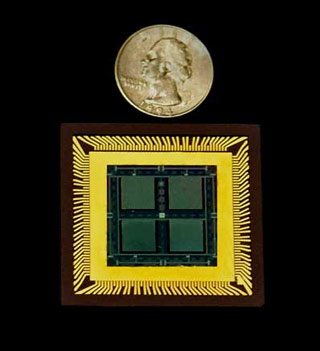Home > Press > No Batteries Required: Automobile Instruments Harvest Energy from Road Vibration to Keep Sensors Running
 |
| Provided/MicroGen Systems Prototype chip from MicroGen Systems includes four piezoelectric power sources. The devices can shrink further as circuits require less power. |
Abstract:
Your little deuce coupe, hot rod Lincoln or pink Cadillac gets a small boost of energy, as tiny sensors in your automobile can now harvest constant power from road vibration instead of replacing batteries.
No Batteries Required: Automobile Instruments Harvest Energy from Road Vibration to Keep Sensors Running
Ithaca, NY | Posted on August 10th, 2011MicroGen Systems Inc., of Ithaca, and Cornell University's Cornell Nanoscale Facility, have collaborated to develop battery-free sensors that can operate in anything that spins, rolls, jiggles or shakes, like car tires and clothing dryers.
The battery device is a tiny sheet of a piezoelectric material that generates electricity when mounted on a shock-resistant base and it is flexed. Vibration like a spinning automobile wheel causes the tiny flap to swing back and forth, generating current that charges an adjacent thin-film battery. The prototype - about the size of a quarter - puts out up to 200 microwatts. As circuits become smaller and need less power, the device can shrink with them.
Several companies have already expressed interest in MicroGen's energy harvester technology.
Robert Andosca, president of MicroGen was first drawn to New York by research funding made available by Sen. Charles Schumer (D-N.Y.). Paul Mutolo, director of external partnerships for the university's Energy Materials Center (emc2), helped bring MicroGen to Ithaca, to be close to Cornell.
To refine the technology, Andosca needed the state-of-the-art facilities at the Cornell Nanoscale Facility. "There are 17 of these facilities in the country and Cornell's facility is one of the two best," says Andosca. Through the Energy Materials Center, MicroGen obtained startup funding from the New York State Foundation for Science, Technology and Innovation (NYSTAR) to support his work at the Cornell Nanoscale Facility. The funding comes from emc2's part in the NYS Center for Future Energy Systems and is targeted to assisting companies in the energy sector. The funding enabled him to build, test and redesign until he had a product that would meet the industry standard power level for wireless sensor units.
Now MicroGen is working with R. Bruce van Dover, professor of materials science and engineering, to refine the technology, particularly to develop a version that can withstand high temperatures, aiming for sensors in jet engines.
####
For more information, please click here
Contacts:
Blaine Friedlander
(607) 254-8093
Copyright © Newswise
If you have a comment, please Contact us.Issuers of news releases, not 7th Wave, Inc. or Nanotechnology Now, are solely responsible for the accuracy of the content.
| Related News Press |
News and information
![]() Researchers develop molecular qubits that communicate at telecom frequencies October 3rd, 2025
Researchers develop molecular qubits that communicate at telecom frequencies October 3rd, 2025
![]() Next-generation quantum communication October 3rd, 2025
Next-generation quantum communication October 3rd, 2025
![]() "Nanoreactor" cage uses visible light for catalytic and ultra-selective cross-cycloadditions October 3rd, 2025
"Nanoreactor" cage uses visible light for catalytic and ultra-selective cross-cycloadditions October 3rd, 2025
Govt.-Legislation/Regulation/Funding/Policy
![]() New imaging approach transforms study of bacterial biofilms August 8th, 2025
New imaging approach transforms study of bacterial biofilms August 8th, 2025
![]() Electrifying results shed light on graphene foam as a potential material for lab grown cartilage June 6th, 2025
Electrifying results shed light on graphene foam as a potential material for lab grown cartilage June 6th, 2025
![]() Institute for Nanoscience hosts annual proposal planning meeting May 16th, 2025
Institute for Nanoscience hosts annual proposal planning meeting May 16th, 2025
Sensors
![]() Sensors innovations for smart lithium-based batteries: advancements, opportunities, and potential challenges August 8th, 2025
Sensors innovations for smart lithium-based batteries: advancements, opportunities, and potential challenges August 8th, 2025
![]() Quantum engineers ‘squeeze’ laser frequency combs to make more sensitive gas sensors January 17th, 2025
Quantum engineers ‘squeeze’ laser frequency combs to make more sensitive gas sensors January 17th, 2025
Announcements
![]() Rice membrane extracts lithium from brines with greater speed, less waste October 3rd, 2025
Rice membrane extracts lithium from brines with greater speed, less waste October 3rd, 2025
![]() Researchers develop molecular qubits that communicate at telecom frequencies October 3rd, 2025
Researchers develop molecular qubits that communicate at telecom frequencies October 3rd, 2025
![]() Next-generation quantum communication October 3rd, 2025
Next-generation quantum communication October 3rd, 2025
![]() "Nanoreactor" cage uses visible light for catalytic and ultra-selective cross-cycloadditions October 3rd, 2025
"Nanoreactor" cage uses visible light for catalytic and ultra-selective cross-cycloadditions October 3rd, 2025
Automotive/Transportation
![]() Sensors innovations for smart lithium-based batteries: advancements, opportunities, and potential challenges August 8th, 2025
Sensors innovations for smart lithium-based batteries: advancements, opportunities, and potential challenges August 8th, 2025
![]() Simple algorithm paired with standard imaging tool could predict failure in lithium metal batteries August 8th, 2025
Simple algorithm paired with standard imaging tool could predict failure in lithium metal batteries August 8th, 2025
Battery Technology/Capacitors/Generators/Piezoelectrics/Thermoelectrics/Energy storage
![]() Rice membrane extracts lithium from brines with greater speed, less waste October 3rd, 2025
Rice membrane extracts lithium from brines with greater speed, less waste October 3rd, 2025
![]() Sensors innovations for smart lithium-based batteries: advancements, opportunities, and potential challenges August 8th, 2025
Sensors innovations for smart lithium-based batteries: advancements, opportunities, and potential challenges August 8th, 2025
![]() Deciphering local microstrain-induced optimization of asymmetric Fe single atomic sites for efficient oxygen reduction August 8th, 2025
Deciphering local microstrain-induced optimization of asymmetric Fe single atomic sites for efficient oxygen reduction August 8th, 2025
|
|
||
|
|
||
| The latest news from around the world, FREE | ||
|
|
||
|
|
||
| Premium Products | ||
|
|
||
|
Only the news you want to read!
Learn More |
||
|
|
||
|
Full-service, expert consulting
Learn More |
||
|
|
||








